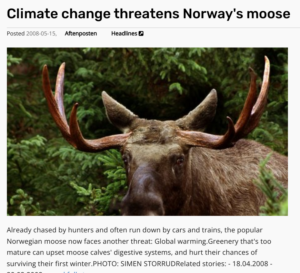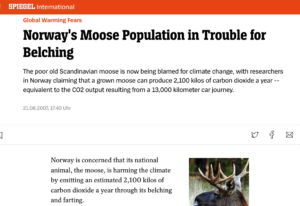Say What? Norway‘s Moose threatened by climate change and causing it!? [ Note: Sounds like the problem will resolve itself!]
See contradictory articles below: 1) Climate change threatens Norway‘s moose (May 15, 2008 –
Aften Posten) versus 2) Norway‘s burping moose blamed for climate change – ‘more destructive to environment than cars’ (August 21, 2007 – Der Spiegel)
1) Climate change threatens Norway‘s moose (May 15, 2008 – Aften Posten)
Excerpt: Climate change threatens Norway‘s moose – Already chased by hunters and often run down by cars and trains, the popular Norwegian moose now faces another threat: Global warming. Greenery that’s too mature can upset moose calves’ digestive systems, and hurt their chances of surviving their first winter. Researchers claim the moose population is threatened by higher temperatures in the spring and early summer that can upset their food supplies. “We’re not in any doubt,” Bernt Erik Sæther of the Norwegian University of Science and Technology (NTNU) in Trondheim told newspaper Aftenposten. “The moose is extremely vulnerable to climate changes. An especially warm spring and early summer can have immediate consequences on the mooses’ reproductive abilities.” That’s because warmer temperatures will lead to earlier sprouting of the greenery on which moose calves feed. If it sprouts early, it may be too dry and fibrous by June, when the calves are born and start to feed. That in turn will cause problems for the calves’ digestive systems and leave them too thin to survive their first winter. “They body weight is like a barometer for climate change,” Sæther said. Researchers had thought Norwegian animals would generally be well-equipped to handle a warmer climate, and even benefit from less snow and ice. Instead, the opposite is true. “We were very surprised by the findings, and that a warmer climate prompts large swings in the moose population,” Sæther said. “But all our analyses point in the same direction.” The research on the moose population, which in general has increased in recent years, is part of the Norwegian Research Council’s NORKLIMA program. http://www.aftenposten.no/
Excerpt: Norway‘s Moose Population in Trouble for Belching. The poor old Scandinavian moose is now being blamed for climate change, with researchers in Norway claiming that a grown moose can produce 2,100 kilos of carbon dioxide a year — equivalent to the CO2 output resulting from a 13,000 kilometer car journey.Norway is concerned that its national animal, the moose, is harming the climate by emitting an estimated 2,100 kilos of carbon dioxide a year through its belching and farting. Norwegian newspapers, citing research from Norway‘s technical university, said a motorist would have to drive 13,000 kilometers in a car to emit as much CO2 as a moose does in a year. Bacteria in a moose‘s stomach create methane gas which is considered even more destructive to the environment than carbon dioxide gas. Cows pose the same problem (more) Norway has some 120,000 moose but an estimated 35,000 are expected to be killed in this year’s moose hunting season, which starts on September 25, Norwegian newspaper VG reported. http://www.spiegel.de/
#
Update 2023: Study suggests moose are contributing to climate change – Fox News – Researchers claim that moose are potentially a leading cause of climate change and that the species should be balanced, suggesting they are “one of the biggest potential single sources of carbon emissions from wooded parts of Norway.” The Norwegian University of Science and Technology studied moose in Norwegian forests for several years and concluded that the species have a major effect on vegetation growth and are altering the carbon cycle by dining on tree buds. “Moose are an ecosystem engineer in the forest ecosystem, and strongly impact everything from the species composition and nutrient availability in the forest. A grown animal can eat 50 kilograms of biomass each day during summer,” Gunnar Austrheim, an ecologist at the NTNU University Museum, said in a press release. Moose tend to eat birch and young samplings in clearcut forests, an act researchers claim is where the ungulates “gobble up” possible carbon storage in trees.




